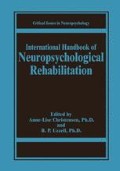Abstract
Rehabilitation in Germany has its roots in the late 19th century when Bismarck created the social security system. As a consequence, rehabilitation was introduced by the pension funds to avoid premature retirement of the working population (rehabilitation before pension), and rehabilitation became a social right for everyone ensured in the social security system. During World War I, neurological rehabilitation was developed to a high standard service for the brain-injured veterans including specialized centers like that, for example, of Kurt Goldstein’s hospital in Frankfurt. After a decline during the years of economic depression it was reorganized during World War II to take care of the many more brain-injured soldiers compared to World War I who survived due to neurosurgery, newly developed in the 1930s, and faster airborne transportation in the fields. With the end of the war, all military hospitals were closed down including the neurological rehabilitation centers.
Access this chapter
Tax calculation will be finalised at checkout
Purchases are for personal use only
Preview
Unable to display preview. Download preview PDF.
References
BAG Bundesarbeitsgemeinschaft medizinisch-beruflicher Rehabilitations-Zentren Phase II. (1994 December). Empfehlungen der Arbeitsgemeinschaft Neurologisch-neurochirurgische Frührehabilitation. [Recommendations of the working group on neurological-neurosurgical early rehabilitation.] Bonn.
BAR (Bundesarbeitsgemeinschaft für Rehabilitation). (1995). Empfehlungen zur Neurologischen Rehabilitation von Patienten mit schweren und schwersten Hirnschädigungen in den Phasen B und C. [Recommendation for neurological rehabilitation of patients with several brain damage in phase B and C.] Frankfurt.
Ministerium für Arbeit, Gesundheit und Sozialordnung, Baden-Württemberg. (1991). Das Apallische Syndrome. [The apallic syndrome.] Stuttgart.
Poser, U., Kohler, J. A., & Schönle, P. W (1996). Historical review of neuropsychological rehabilitation in Germany. Neuropsychological Rehabilitation, 6, 257–278.
Schönle, P. W. (1990). Die Einordnung der Frührehabilitation in den Ablauf der Neurologischen Rehabilitation: ein explizites Gesamt-Phasenmodell. [Early rehabilitation in neurological rehabilitation: An explicit phase model.] Allensbach: Kliniken Schmieder.
Schönle, P. W. (1995a). Möglichkeiten und Bedingungen der Rehabilitation bei und nach apallischen Syndrom—von der Akutphase bis zur Wiederherstellung in der Familie. [Possibilities and conditions of rehabilitation of patients in the apallic syndrome from the acute phase till reintegration in the family.] In: K. D. Voß, W. Blumenthal, F. Mehrhoff, & M. Schmollinger (Eds.), Aktuelle Entwicklung in der Rehabilitation am Beispiel neurologischer Behinderungen [Current developments in rehabilitation and the case of patients with neurological handicaps.] (pp. 261–274 ). Ulm: Universitätsverlag.
Schönle P. W. (1995b). Der Frühreha-Bartelindex (FBI)—eine früh-rehabilitationsorientierte Erweiterung des Barthelindex. [The Early-Rehab-Barthel Index—an early-rehab extension of the Bartol index.] Rehabilitation, 34, 69–73.
Schönle, P. W. (1996a). Personale Anforderungsprofile in den frühen Phasen der Neurologischen Rehabilitation. [staff requirement in the early phases of neurological rehabilitation.] Neurology and Rehabilitation, 3, 165–175.
Schönle, P. W. (1996b). Rehabilitation bei Patienten mit Schädelhirntraumen. [Rehabilitation of patients with traumatic brain injury.] Nervenheilkunde, 15, 200–205.
Schönle, P. W. (1997). Ambulante Neurologische Rehabilitation. [Outpatient neurological rehabilitation.] Neurologie und Rehabilitation, 2, 87–95.
Schönle, P.W. (1998). Phasen der neurologisch-neurochirurgischen Rehabilitation und ihre Entwicklung aus der rehabilitativen Praxis einer deutschen Klinik [Phases of neurological-neurosurgical rehabilitation and its development in a German hospital.] (pp 98–119 ). Schorndorf: Weber Verlag.
Schönle, R W, & Schwall, D. (1995). Die KRS—eine Skala zum Monitoring der protrahierten Komaremission in der Frührehabilitation. [KRS-coma-remission Scale-monitoring prolonged coma remission in early rehabilitation.] Neurologie und Rehabilitation, 2, 87–96.
Schönle, R W, & Schwall, D. (1993a). Habituation des Blinkreflexes —Prognostisches Kriterium für Patienten im apallischen Durchgangssyndrom. [Habituation of the blink reflex as a prognostic factor in apallic syndrome patients. In: K. Schimrigk, A. Haaß, & G. Hamann (Eds.), Verhandlungen der Deutschen Gesellschaft fir Neurologie 7 [Transactions of the German Neurological Society] (pp. 387–393 ). Berlin: Springer-Verlag.
Schönle, R. W, & Schwall, D. (1993b). Habituation des Blinkreflexes als Zeichen früher Lernvorgänge bei apallischen Patienten. [Habituation of the blink reflex as an indicator of early learning in the apallic patient.] In: K. von Wild (Ed.), Spektrum der Neurorehabilitation, [Spectrum of Rehabilitation] (pp. 158–163 ). München: W. Zuckschwerdt Verlag.
VDR (Verband Deutscher Rentenversicherungsträger). [Union of German Pension Funds]. (1995). Phaseneinteilung in der neurologischen Rehabilitation. [Phases in neurological rehabilitation.] Rehabilitation 34, 119–127.
Author information
Authors and Affiliations
Editor information
Editors and Affiliations
Rights and permissions
Copyright information
© 2000 Springer Science+Business Media New York
About this chapter
Cite this chapter
Schönle, P.W. (2000). Neurological Rehabilitation in Germany. In: Christensen, AL., Uzzell, B.P. (eds) International Handbook of Neuropsychological Rehabilitation. Critical Issues in Neuropsychology. Springer, Boston, MA. https://doi.org/10.1007/978-1-4757-5569-5_22
Download citation
DOI: https://doi.org/10.1007/978-1-4757-5569-5_22
Publisher Name: Springer, Boston, MA
Print ISBN: 978-1-4419-3324-9
Online ISBN: 978-1-4757-5569-5
eBook Packages: Springer Book Archive

